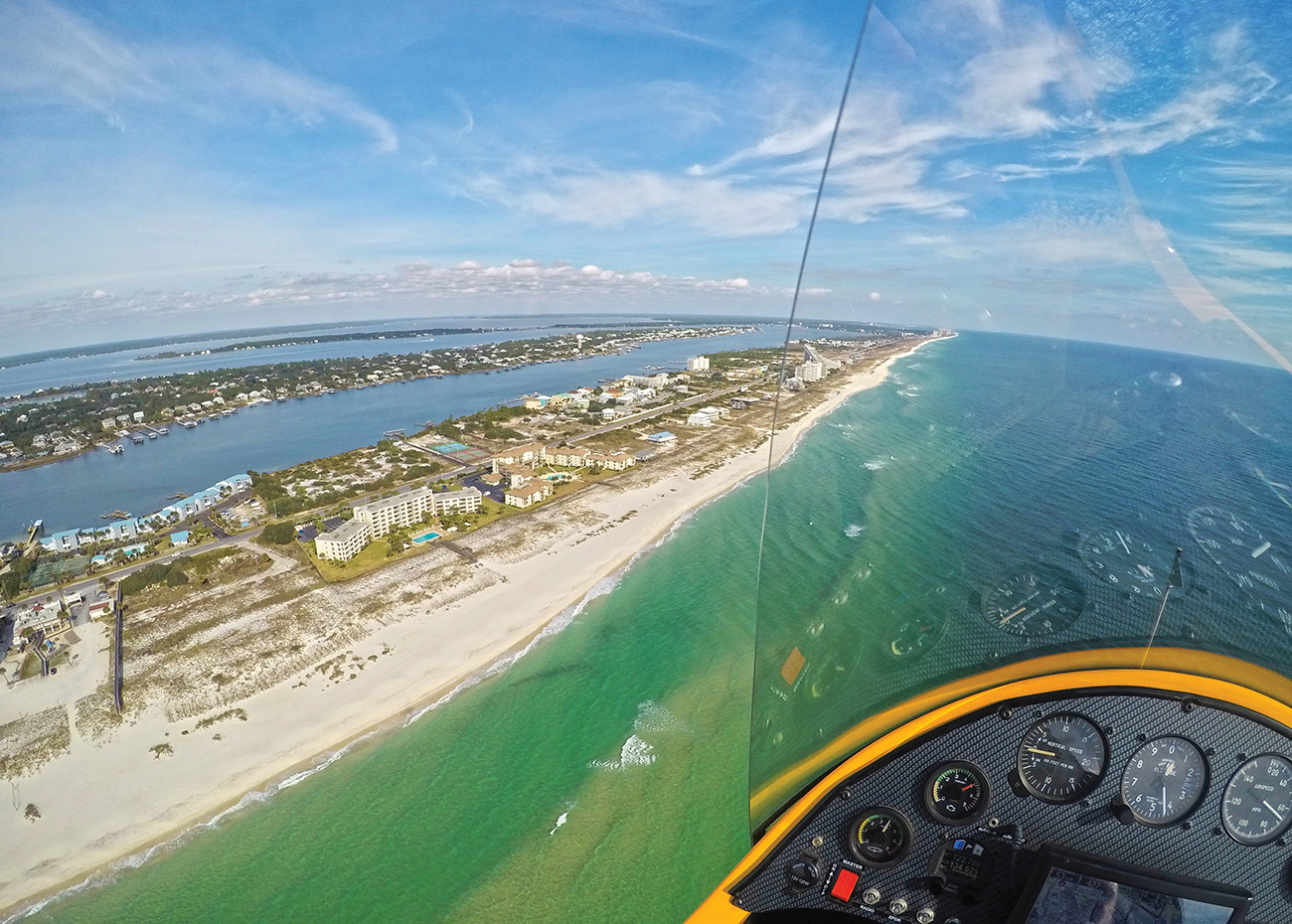
It’s a sunny spring day, and a salty breeze is blowing across the Jack Edwards National Airport in Gulf Shores. I’m about to meet pilot Gary Berdeaux, owner of BeachFlight Aviation, and it’s a perfect day for flying.
I first learned of Berdeaux when I came across a YouTube video about gyroplanes. Upon reading that he takes passengers for introductory flights along the coast, I was hooked; gyros shot to the top of my bucket list. I’ve been around aircraft much of my life, but I had never seen a vehicle like this.
The “bird” is perched outside Salt Air Aviation Center, ready to fly. At my first glimpse, I’m taken aback. The airship is smaller than I expected, and it looks more like an oversized tricycle than a plane. The minimal composite fuselage has no doors, windows or roof and sits only a few feet off the ground. There’s a rotor mounted on top, and the engine and propeller sit behind the passenger. To top it all off, one word is stenciled on the rudder in bold, black letters — EXPERIMENTAL. What have I signed up for?
Our pilot rounds the corner, smiles and extends a welcoming hand. He must have noticed my wide eyes because he doesn’t miss a beat. “This is probably the safest airplane you will ever ride in,” he explains. “Even if I lose the engine, I can use the rotor to autogyro to the ground and make a soft landing. As long as the craft is moving forward, it can be flown.” I learn a gyro can take off using just the length of a football field and can land in as little as 30 feet. My anxiety turns to awe.
After a preflight briefing, it’s showtime. I don flight gear — headset, helmet, jacket — and climb in canoe-style. With one leg over the side, I shoehorn myself in. The fuselage cradles my hips like a race car. Berdeaux cranks the engine and begins our taxi. Through the headset, I hear his voice slide into business mode. Since this is a non-towered field, the pilots manage traffic themselves with terse “here’s who we are and what we are doing” language. His head swivels, clearing the airspace before he taxis onto the active.
The motor roars, and the engine pushes us forward. The pilot engages the rotor and borrows some of the motor’s power to pre-rotate. As it reaches liftoff speed, the rotor becomes a free-spinning wing. Through the miracle of airflow and aerodynamics, the unpowered rotor will keep us aloft for the rest of our flight.

A fixed-wing aircraft would be going faster at this point, and we would be pushed back into the seat, but takeoff in a gyro is much gentler, a sensation similar to riding an elevator to a higher floor. Berdeaux banks right and leaves the pattern, pointing the craft toward the coast as he climbs to 1,000 feet. Our shadow, off to the right, tags along and banks as we do, following the contours of the land.
As we go higher, 360 degrees of landscape come into view. A golf course with manicured fairways and greens passes beneath. To the south, the emerald beach stripe that gives our coast its nickname hugs the shore. Waters of the Gulf stretch to the horizon in three directions.
I’ve traveled the county for years but am amazed at the arrow-straight roads that point north. Rivers and bays I’ve never seen are everywhere. All this time, Berdeaux, in his tour-guide persona, is pointing out sights I have missed. Groups of sharks offshore. A camouflaged Army chopper below, almost invisible against the vegetation. I’m seeing land I thought I knew, but today I have a bird’s-eye perspective.

Too soon, it’s time to return. Can the landing be as exciting as takeoff?
Berdeaux transitions again into business voice. He points out traffic in the landing pattern and broadcasts our position and intentions. The pattern shifts to accommodate our size and speed. When flying commercial, landing can be a tense moment. I tighten, anticipating the “commercial thud” of landing and the quick blast of thrust reversers. How is this little bird going to land?
Berdeaux crosses the end of the active and abruptly cuts power to the prop. I wonder if something is wrong. No, this is how a gyro lands. When he cuts the engine, he lowers the nose a bit to maintain forward momentum and autogyros our bird to the tarmac. Instead of a thud, we land like a feather floating down to kiss the runway. Riding a gyro is the gentlest, least scary flying I have ever done.
To learn more, and to see about taking your own gyroplane flight (post quarantine, of course!), visit beachflight.com.





